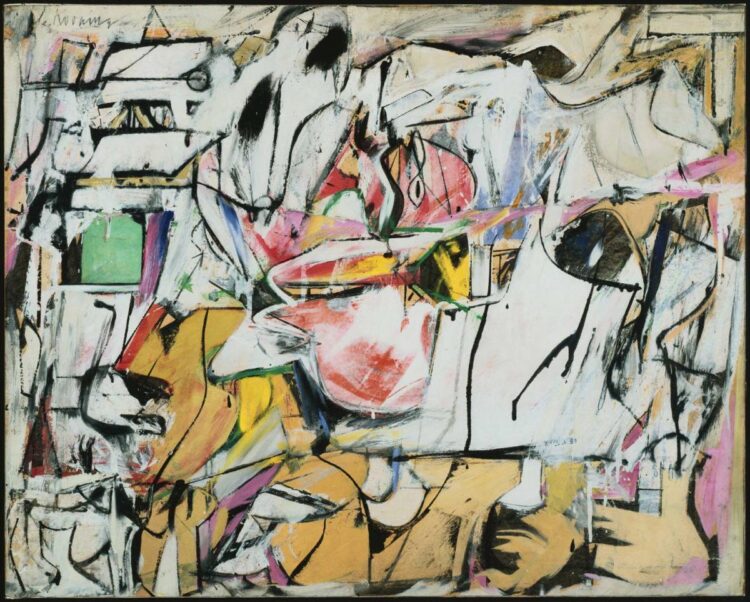Currently on view at the Phillips is One-on-One: Bridget Riley / Pierre-Auguste Renoir, a special installation in which Riley selected three of her works to be displayed alongside Renoir’s Luncheon of the Boating Party. Visitor Services Associate and Marketing and Communications Detail Ben Hough shares which artwork from the Phillips’s collection he would select for his One-on-One installation.
“I’m not interested in abstracting or taking things out or reducing painting to design, form, line, and color. I paint this way because I can keep putting more things in it—drama, anger, pain, love, a figure, a horse, my ideas about space. Through your eyes it again becomes an emotion or idea.”—Willem de Kooning
Abstract expressionism is defined as a subjective emotional expression with particular emphasis on conveying diverse styles and techniques through nontraditional and usually nonrepresentational means. Willem de Kooning’s abstract representation allowed him to use his unique art-making process as a tool to express personal thoughts and ideas, providing a deeper understanding of his mind. As an artist myself, I also tend to focus on nonrepresentational subject matter like de Kooning. While there is the occasional literal subject within my work, I don’t pertain to a specific style when it comes to self-expression.

Willem de Kooning, Asheville, 1948, Oil and enamel paint on cardboard, 25 9/16 x 31 7/8 in., The Phillips Collection, Acquired 1952
Since de Kooning’s techniques have led to new advances in the art world, artists like me now have the freedoms to experiment and play with what art making can provide to the audience. De Kooning’s Asheville shows his iconic nonrepresentational configuration that he used throughout his life to express his ideas of the emotional legacy of World War II and the array of influences available to him at the time of peak modernistic idioms. While I do not paint to reflect the legacy of war, understanding where the piece is coming from conceptually provides a new way of thinking when creating. At first glance of Asheville, I asked myself what his objective was—there had to have been a deeper intention behind this very conceptual composition and color story. Was every brushstroke deliberate? Was the addition of collage used to show his ideas of experimentation? Or was there some sort of further understanding of how these nontraditional materials would affect the tone of the piece? De Kooning’s rudimentary approach gives works like Asheville a definitive tone and allows the concept of modern art to be recognized deeper than what’s on the surface of the work.
This sense of experimentation is reflected in my own work. Using color, line, and ideas of emotions and conscious thoughts, like de Kooning, I express my intentions with confidence, rarely ever sketching the work beforehand in the traditional way and approaching the surface of the canvas with a perception of familiarity. This process, while intentionally allowing me the freedom to produce unique and meaningful works, also demonstrates new techniques and gives me the chance to explore new ways of art making. Fundamental to de Kooning’s art is also the meaning of reality. At the start of his lifetime the era of modern art was already well established—masters like Pablo Picasso and Wassily Kandinsky had changed the way art was perceived at the time. De Kooning grew up with the influence of these recognized artists, which guided his own process to what it would become by the mid-1900s.

Ben Hough, Stupid Thoughts, 2021, Acrylic and oil pastel on canvas, 12 x 36 in.
Within my own work and the use of acrylic and oil pastel, Stupid Thoughts derives from the ideas of sadness, pain, and confusion. Below the surface of the work are words and thoughts I intended to physically visualize before the start of the layering process. Approaching the canvas in this way sets the tone for a piece and with the use of various mediums gives me the same experimental application process de Kooning used for several of his works. With line I intended to show a clear distinction of boldness and precision contradictory to the idea of confusion and pain associated with the first layer of color and text. Central to de Kooning’s suggestion and influence of the modernistic idioms, my works are heavily influenced by my perspective of the world and the subjects that make me question my own impressions.
Since joining as a Visitor Services Associate last fall, having the freedom to walk the halls of The Phillips Collection and lay eyes on countless masterpieces has been one thing I know I won’t have the privilege of experiencing in such an intimate way anywhere else. Works like de Kooning’s continue to deepen the conversation of what expressionistic art has to offer artists and the world in general. Nontraditional creativity is a concept that must remain, without it we are stuck in the past and while we can certainly learn from past masters we live in a time where art is forever changing. Artists like de Kooning show that influence can create an entirely new field and method of art making.

Visiting The Phillips Gallery was the first time I was blown away by painting. Coming up the stairs and being confronted by The Boating Party. And then the Klee exhibit. I have never forgotten. I was on a field trip with the art class in junior high. I lived in Arlington at the time. Years later i graduated from Pratt Institute. I still am painting. I will soon be 80. But I’ll always remember the power of art. Happy to see this blog. Congratulations. Wonderful Kandinsky.